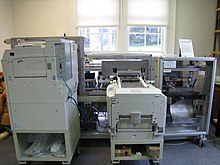
Back طباعة عند طلب Arabic Impressió per encàrrec Catalan Tisk na požádání Czech Print-on-Demand German Impresión bajo demanda Spanish Nõudetrükk Estonian چاپ بنابر تقاضا Persian Tarvepainatus Finnish Impression à la demande French Print on demand Hungarian
This article has multiple issues. Please help improve it or discuss these issues on the talk page. (Learn how and when to remove these template messages)
|

Print on demand (POD) is a printing technology and business process in which book copies (or other documents, packaging, or materials) are not printed until the company receives an order, allowing prints in single or small quantities. While other industries established the build-to-order business model, POD could only develop after the beginning of digital printing[1] because it was not economical to print single copies using traditional printing technologies such as letterpress and offset printing.
Many traditional small presses have replaced their traditional printing equipment with POD equipment or contracted their printing to POD service providers. Many academic publishers, including university presses, use POD services to maintain large backlists (lists of older publications); some use POD for all of their publications.[2] Larger publishers may use POD in special circumstances, such as reprinting older, out-of-print titles or for test marketing.[3]
- ^ Kleper, Michael L. (2000). The Handbook of Digital Publishing. Vol. II. ISBN 0-13-029371-7.
{{cite book}}:|work=ignored (help) part of the Encyclopedia of Printing Technologies in 2 volumes. - ^ Scott Jaschik (31 July 2007). "New Model for University Presses" (electronic). insidehighered.com. Archived from the original on 12 August 2007. Retrieved 14 August 2007.
- ^ Snow, Danny (February 2001). "Print-on-Demand: The Best Bridge Between New Technologies and Established Markets". BookTech: The Magazine for Publishers.
© MMXXIII Rich X Search. We shall prevail. All rights reserved. Rich X Search